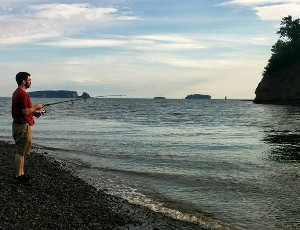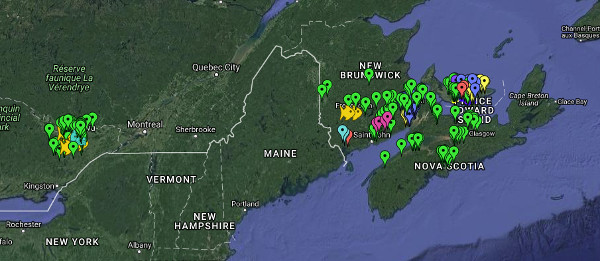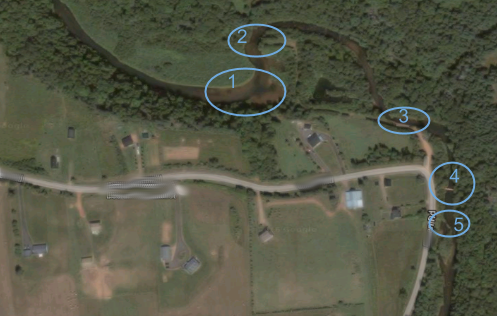
Whether you’re an angler that has just moved to a new area, a newbie angler with no idea where to start, are on vacation, or a veteran of the area that has grown bored of your usual spots, we have all at one time or another wondered how to find new fishing spots. The list below mentions some of the best ways to discover new fishing holes, as well as some techniques to use when fishing in new areas.
I have used many of the following strategies myself to find extremely productive fishing holes. I encourage other anglers to give some of these strategies a try, just don’t find my personal honey holes please!
Google Maps
This is my favourite method of discovering new fishing holes. I use the “my maps” option of Google Maps to mark my fishing spots down for future reference. This map feature allows you to mark all the possible fishing spots you discover by using other methods on this list. You can also add notes to every marker you place. This allows you to make notes on different species in the area, fishing conditions, special fishing regulations, and any other relevant information. You can also use different icons and colour code markers. I code mine to indicate pieces of information that I would like to see at a glance (such as if it’s wadable or not).

The only drawback of using the mymaps feature is that it lacks street view. When looking for new fishing spots, I have two separate tabs open when using Google Maps. One tab has my personalised fishing map on mymaps, and the other tab has the traditional Google maps open so I can use street view to get a closer look at different bodies of water.
The following is one example of how to use Google Maps to find fishing spots. When looking for fishing spots on a river, scroll around the coast until you find a location where the river drains into the ocean, lake, or larger river. Look up along the river and it’s tributaries, and make a note of any fishy looking areas along the way. With rivers you are looking for larger structure that you can see from the satellite photos provided in Google Maps. Some features of the river to look for include:
- Area’s where tributaries merge with the main river.
- A widening of the river.
- Bridges.
- Obstructions in the river.
Locations where a road intersects the river are of special interest because bridges often make for excellent fishing, and offers easy of access to the water. Many times you can go into street view and look at the river from the bridge right in Google maps! If there is no street view available there may be static pictures of the area that you can also take a look at. Street view is not just limited to road side fishing areas, beaches and trails often have street view options available by bodies of water as well. If the potential fishing hole is in a more rural area, neither street view or pictures may be available and you’ll have to take a drive and look at the potential fishing spot yourself.

The picture above is one of the local mediocre rivers. It is a well known trout river on PEI as it passes through the highway just downstream from this picture. I know I’m not burning anyone’s secret hole by posting it because everyone in the area already knows about it. The image is just a demonstration of some of the things to look for when using Google Maps. Just because an area looks fishy from the satellite image, doesn’t necessarily mean it’ll be productive when you get there. You won’t know for sure until you actually go to the river and fish it yourself!
Coastal areas are a bit different than rivers because you are going to look for different features, and the features you are looking varies according to your targeted species. Most fish have preferences relating to current, structure, and depth. If I’m looking for striped bass, rocky shores or areas with strong tidal flows will catch my attention. If I’m looking for flounder, the fishing spots I’ll be looking for will have sandy areas with slight drop offs and some sort of water flow. Sorry, I’m not posting any example pictures for tidal areas because I don’t frequent any coastal areas that are well known, only my secret spots!
Some features to look for in coastal and tidal areas include:
- Wharves and docks, both functional and abandoned.
- Breakwaters.
- Tidal rips.
- Drop off’s indicated by darker water.
Another very useful tool (that I don’t use often enough) is Google Earth. It’s similar to Google map, but some some major differences. The most useful feature of Google Earth for the angler is that is has historical photos. You can go to an area, and see what it looked like in years and seasons past.
Using Google Earth like this, you can see what the conditions are at a fishing spot based on the season. You can how much it floods in the spring, what the weed-lines are like in the summer, if the water level drops throughout the year, and much more seasonal information by looking at the historical photos.
Fishing Apps
Using fishing apps to discover new fishing spots is perhaps one of the most effective methods for finding new fishing spots, especially when used in conjunction with Google maps. The most useful app I’ve found for this is Fishbrain, although this may vary based on your location.
Fishbrain is an app where users can post pictures of their catch to specific bodies of water. This is very useful to see what species and size of fish people are catching in any given body of water. It also has the option to post the bait, lure, or fly used with the catch, you can see what fishing methods are working for other anglers. The option to follow bodies of water means that you can get a notification anytime someone posts a catch in that lake, river, or bay. You can also follow specific anglers to get a notification anytime that person posts a catch.
You can also use it as an alternative to the mymaps feature of Google Maps listed above but posting your catches to the Fishbrain app instead. The best part about this app is that it’s free!
There may be other useful fishing apps out there, but I have yet to discover any as widely used and useful as fishbrain. If you know of any please let me know in the comments below!
Fishing Forums
If you have a fishing forum in your area, check it out. You’ll be able to easily find the more well known areas, and might even find a more elusive area mentioned by some careless angler! You can ask for help if you feel like it, but I find it more effective to just browse existing posts. The really cool thing about forums is that not only will you find new locations, you’ll learn what lures, flies, and fishing methods are working in the area.
Facebook groups are a variation of fishing forums. A local fishing Facebook group is going to have pictures showing off catches, and my times people will say where they caught it. Fish and wildlife Facebook groups run by government or non-profit organizations will often have information about fishing locations as well.
Fly shops and Tackle shops
Tackle shop owners have a vested interest in you being a successful angler. If you are consistently catching fish, you are much more likely to buy tackle, bait, and equipment from them. The owners will most likely share a few well known, but still quite productive areas with you to ensure you catch a fish and become a returning customer. Many shop owners and employees are anglers themselves, and will keep the very best spots secret.
Other Anglers
When you are out on the water, chat up other anglers. It’s a great way for you two to swap experiences and will make you both better anglers. Mention that you’re new to the area, and if the angler is feeling generous he might give you some pointers like favourite local patterns, or even a good fishing spot. If the other angler isn’t voluntarily giving up any information don’t press the issue, I’m sure we can all appreciate having fishing secrets we don’t feel like sharing!
Important! As anglers, we need to maintain some level of secrecy with fishing locations. A small fishing hole can very quickly become overfished if to many people know about it. So If a angler by some miracle shares their secret spot with you, keep it to yourself!
If you buy anything below, I get some beer money.
Take a Drive or Walk
Sometimes the best way to track down a honey hole is to go out there and search for it! Take a Sunday drive out in the country to find some new rivers, ponds, and lakes. It really helps if you scout out fishy looking areas in Google Maps first! I tend to do this during times when fishing is sub-optimal.
My fiancée likes to hike, and I have discovered several prime fishing spots while spending a Sunday afternoon on a hike through the woods, or walk down the beach with her. Another idea is to take your little ones to the beach during low tide to look at all the critters in the tidal pools. While they’re marvelling at the pretty shells, sea stars, and funny hermit crabs, you can take mental notes of the structure on the beach. Come back at high tide and fish the promising looking spots.
Guides
If you are on vacation, it’s unlikely you have time to discover fishing holes yourself. This is the prime time to hire a guide. They know all the best fishing spots in the area, and all the fishing techniques that are effective in the area. Soak it all in as they are extremely experienced and can teach you so much about casting, presentation, and locating fish. Even if you are not on location it can be worth while to hire a guide because they are so knowledgeable about what works in the area, and you can apply that knowledge to other bodies of water nearby.
Final Thoughts
When I first moved from New Brunswick to Prince Edward Island, I had no idea what rivers to fish, which beaches to try, or even what species to target. I did end up changing my fishing style and that is an important thing to consider if you are looking at fishing in a new area. In New Brunswick striped bass were my preferred species, but the striped bass population on PEI is mostly transient. While striper fishing is still present on PEI, I now find myself targeting the plentiful sea run brookies and steelhead that fill PEI’s spring fed rivers much more often.
While it can be frustrating finding fishing spots in a new area, hopefully these strategies will help you get started. Good luck and tight lines!

Ben
It;s like I’m looking in a mirror!
All of the above resources + Backroad Maps,available at Canadian Tire. They show complete drainage patterns in detail.
That’s really cool, I don’t think the Canadian Tire around here has resources like that though. You’re quite luck to have resources like that!